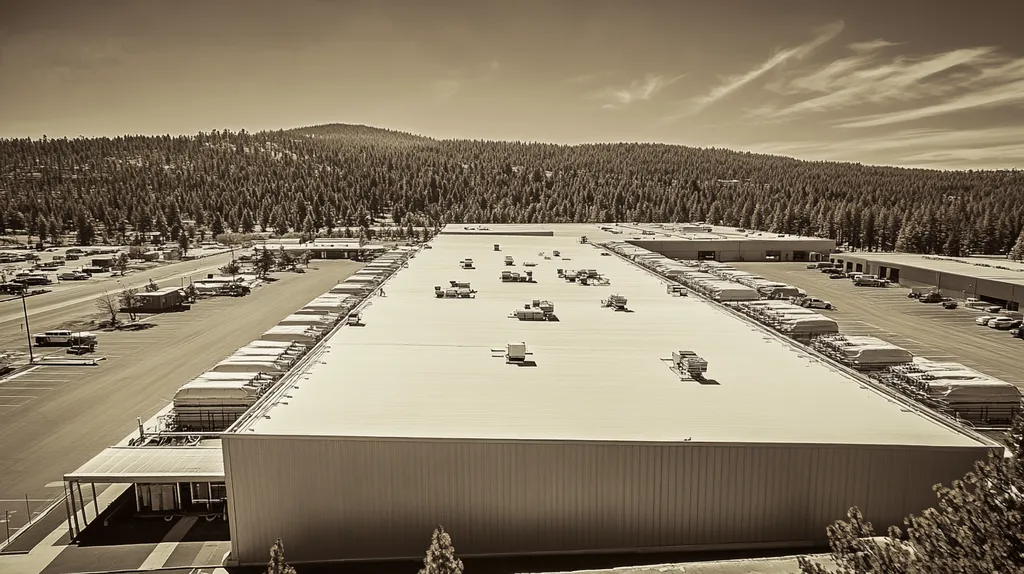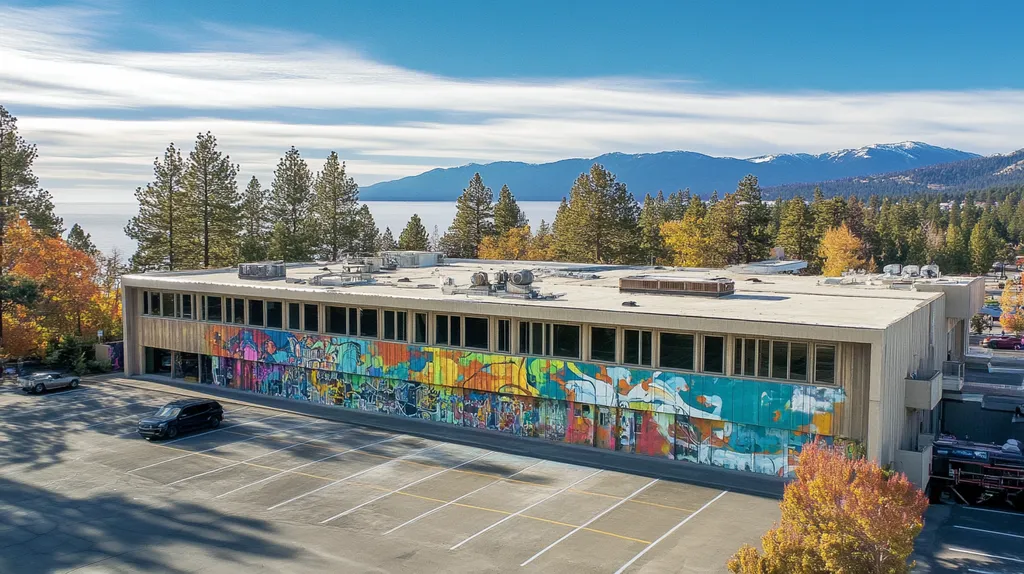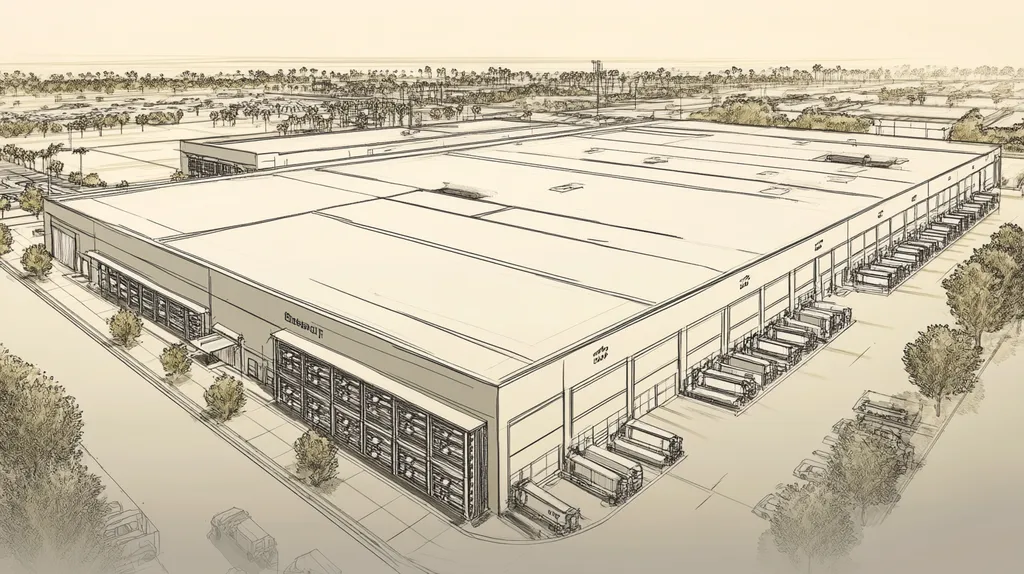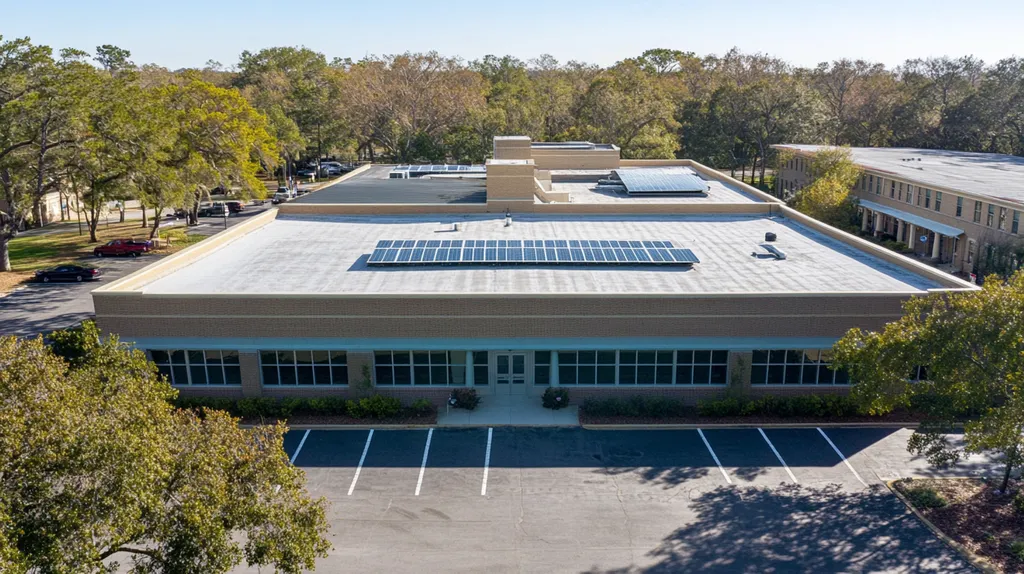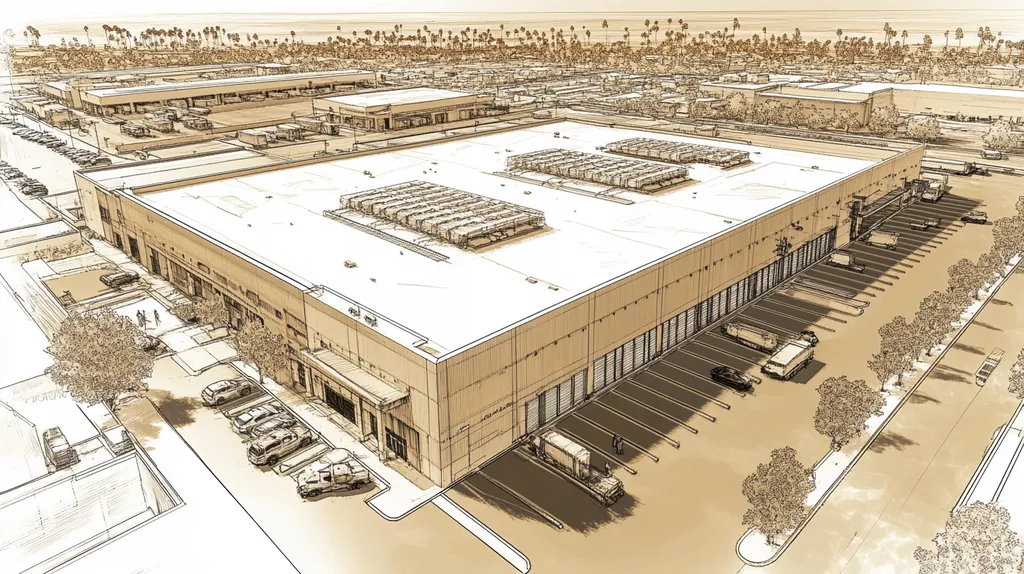Welcome to today’s Battle Royale featuring two roofing heavyweights: “Flat Roofs” in the east corner versus “Pitched Roofs” in the west!
Tonight’s showdown pits these contenders against each other across six punishing rounds designed to test every aspect of their performance for Commercial Roof Shape and Appearance.
At stake? Millions in potential costs, decades of building protection, and the critical performance demands of modern commercial and industrial facilities.
Our professional judging panel will evaluate each round on technical merit, real-world performance, and value delivery. After all six rounds, we’ll declare our ultimate champion.
Ladies and gentlemen, facility managers and building owners… it’s time to rumble!
ROUND 1: INITIAL COSTS & INSTALLATION
When it comes to commercial roofing, the battle between flat and pitched options starts with dollars and cents. Property owners face a crucial decision that can impact their bottom line for decades. While initial costs often drive decision-making, installation complexity and timeline considerations can dramatically affect the total investment.
Material Expenses
Flat roofs typically require fewer materials per square foot, making them an attractive option for budget-conscious property owners. Basic single-ply membranes and built-up roofing systems offer economical solutions starting around $4-6 per square foot for materials.
Pitched roofs demand more materials due to their geometric design and overlapping requirements. Metal panels, tiles, or architectural shingles can push material costs to $8-15 per square foot, while specialty materials like slate can soar even higher.
The larger the building footprint, the more these differences compound. For a 20,000-square-foot commercial facility, the material cost difference between flat and pitched options could exceed $100,000.
ADVANTAGE: Flat Roofs
Installation Complexity
Flat roof installation follows a relatively straightforward process. Crews can move efficiently across the surface, installing membrane or built-up systems with minimal specialized equipment or safety concerns beyond standard fall protection.
Pitched roofs present significant challenges in the commercial setting. Workers need specialized scaffolding, safety equipment, and installation techniques to handle steep slopes and height variations. This complexity increases labor hours and equipment requirements.
Weather sensitivity also plays a major role. While both types face weather delays, pitched roof installation becomes particularly dangerous in wind or rain, leading to more frequent work stoppages.
ADVANTAGE: Flat Roofs
Project Timeline
A typical commercial flat roof installation progresses at a predictable pace. Crews can cover large areas quickly, often completing 5,000-10,000 square feet per day under optimal conditions.
Pitched roof installations move more slowly due to their three-dimensional nature. Workers must constantly adjust positions, secure materials on slopes, and deal with more complex flashing details around peaks and valleys.
These timeline differences directly impact business operations. While a flat roof might be completed in a week, an equivalent pitched roof could require two to three weeks, extending the period of potential disruption to building occupants.
ADVANTAGE: Flat Roofs
ROUND 1 WINNER: Flat Roofs
ROUND 2: DURABILITY & LIFESPAN
Time is the ultimate test of any commercial roof, and the battle between flat and pitched designs plays out over decades. While both options can protect your facility, their long-term performance characteristics differ dramatically. Understanding these differences is crucial – a wrong choice today could mean millions in repairs tomorrow.
Weather Resistance
Flat roofs face unique challenges when confronting Mother Nature. Standing water, known as ponding, can accelerate membrane deterioration and create structural stress points that demand constant monitoring.
Pitched roofs naturally shed water, snow, and debris thanks to gravity’s helping hand. Their sloped design minimizes the risk of ponding and reduces the strain on roofing materials during heavy precipitation.
While modern flat roof materials have improved significantly, they still can’t match the natural weather-resistance advantages of a pitched design. This fundamental physics advantage makes pitched roofs the clear winner for weather protection.
ADVANTAGE: Pitched Roofs
Material Longevity
Commercial flat roofs typically last 20-30 years when properly maintained. Single-ply membranes and built-up systems require regular inspections and prompt repairs to achieve their full lifespan potential.
Pitched commercial roofs commonly deliver 30-50 years of service. Metal panels, architectural shingles, and other slope-appropriate materials maintain their integrity longer due to reduced exposure to standing water.
The significant lifespan difference makes pitched roofs the more durable option for long-term facility planning. While both types require maintenance, pitched roofs provide more forgiveness when maintenance schedules slip.
ADVANTAGE: Pitched Roofs
Maintenance Requirements
Flat roofs offer unmatched accessibility for inspections and repairs. Maintenance teams can easily walk the surface to identify and address issues before they become major problems.
Pitched roofs present significant challenges for routine maintenance. Their steep slopes require specialized safety equipment and often demand more expensive skilled labor for even minor repairs.
The ease of maintenance access gives flat roofs a crucial advantage for facility managers focused on preventive care. This accessibility translates into faster response times and lower maintenance labor costs.
ADVANTAGE: Flat Roofs
ROUND 2 WINNER: PITCHED ROOFS
ROUND 3: PERFORMANCE FACTORS
Performance factors can make or break a commercial roofing investment, impacting everything from daily operations to long-term facility costs. While initial installation decisions matter, it’s the ongoing performance characteristics that determine whether a roof becomes an asset or liability over its lifetime.
Thermal Management
Heat management capability directly impacts building energy costs and occupant comfort. Flat roofs often struggle with heat absorption, creating significant thermal loads that strain HVAC systems during summer months.
Pitched roofs provide natural ventilation through their design, helping regulate building temperatures more effectively. Their slope creates air movement that assists in heat dissipation and moisture control.
The ability to incorporate additional ventilation features and thermal barriers gives pitched roofs a distinct performance edge in managing building temperatures throughout the year.
ADVANTAGE: Pitched Roofs
Structural Impact
Flat roofs place consistent, evenly distributed loads on building structures. However, they must be engineered to handle potential ponding water and snow accumulation, which can create significant weight concerns.
Pitched roofs naturally shed precipitation, reducing the risk of excessive load concentration. Their design helps distribute weight more effectively across supporting structures.
While both designs can be engineered safely, the self-clearing nature of pitched roofs provides better long-term structural performance with fewer potential failure points.
ADVANTAGE: Pitched Roofs
Space Utilization
Commercial roofs tend to have flat or only slightly sloped designs, maximizing usable interior space without visibility concerns from ground level. This configuration allows for efficient HVAC placement and easier access for maintenance teams. (source: Nations Roof)
Pitched roofs create unusable angles in upper building areas, reducing potential storage or mechanical equipment placement options. Their slope also complicates access for maintenance and repairs.
The practical advantages of maximizing usable space and simplified access make flat roofs the clear winner in operational functionality.
ADVANTAGE: Flat Roofs
ROUND 3 WINNER: PITCHED ROOFS
ROUND 4: MAINTENANCE REQUIREMENTS
The maintenance battle between flat and pitched roofs can make or break your facility’s bottom line. Poor maintenance choices lead to premature failures, with the average commercial roof leak causing $7,000 in damage. Whether you’re managing a warehouse or retail complex, understanding these critical maintenance differences will determine if your roof becomes a reliable shield or an endless money pit.
Inspection Frequency
Flat roofs demand vigilant inspection schedules due to their unique vulnerabilities. Property managers typically need quarterly professional inspections plus additional checks after severe weather events to catch developing issues early.
Drainage systems, seams, and membrane condition all require constant monitoring. Even minor oversights can cascade into major problems, as standing water accelerates deterioration and compounds structural stress.
Pitched roofs benefit from natural drainage that reduces inspection demands. Most pitched systems only require semi-annual professional inspections unless damaged by severe weather or falling debris.
ADVANTAGE: Pitched Roofs
Access and Safety
Flat roofs provide superior maintenance access, allowing teams to walk the surface safely with standard fall protection equipment. This easy access translates to faster repairs and lower labor costs for routine maintenance tasks.
Working safely on pitched roofs requires specialized equipment and advanced safety protocols. The steep angles create challenging conditions that slow work progress and increase labor expenses.
The practical advantages of safe, efficient access make flat roofs the clear winner for maintaining critical rooftop equipment and performing regular maintenance tasks.
ADVANTAGE: Flat Roofs
Repair Complexity
Flat roof repairs often involve complex layered systems that must be carefully matched and integrated. Even small patches require precise technique to prevent water infiltration at seams and transitions.
Pitched roof repairs tend to be more straightforward, typically involving individual shingle or panel replacement. The sloped design helps protect repairs from standing water, increasing their likelihood of success.
While both systems require skilled technicians, pitched roofs generally offer more forgiving repair conditions and better long-term repair performance.
ADVANTAGE: Pitched Roofs
ROUND 4 WINNER: Pitched Roofs
ROUND 5: SUSTAINABILITY CREDENTIALS
With commercial buildings accounting for nearly 40% of U.S. energy consumption, roofing choices directly impact both environmental footprints and operating costs. As municipalities tighten green building requirements and energy prices soar, sustainability has evolved from feel-good buzzword to bottom-line imperative.
Energy Efficiency
Flat roofs excel at hosting energy-saving technologies. Their expansive, unobstructed surfaces provide ideal platforms for solar panels, reflective coatings, and green roof systems.
The uniform surface allows for continuous insulation layers without gaps or compression points. This consistency helps maintain optimal thermal performance across the entire roof area.
Pitched roofs create challenges for solar installation and limit options for additional efficiency measures. While their slope can aid ventilation, the angular design restricts placement of modern energy-saving systems.
ADVANTAGE: Flat Roofs
Material Sustainability
Modern flat roof materials increasingly incorporate recycled content and offer end-of-life recyclability. Single-ply membranes can contain up to 95% recycled materials, while maintaining performance standards.
Installation methods for flat roofs typically generate less waste, as materials can be precisely measured and cut. Many components can be reused or recycled during roof replacement.
Pitched roof materials often rely heavily on virgin resources and petroleum products. Their installation creates more waste due to complex cutting patterns and overlap requirements.
ADVANTAGE: Flat Roofs
Environmental Impact
Flat roofs provide excellent opportunities for reducing urban heat island effects. White or light-colored membranes can reflect up to 80% of solar radiation, dramatically lowering cooling demands.
These systems also enable green roof installations that support biodiversity, manage stormwater, and improve air quality. Vegetation and growing media can transform barren rooftops into productive environmental assets.
Pitched roofs offer fewer options for environmental enhancement. Their slope limits vegetation possibilities and complicates stormwater management strategies.
ADVANTAGE: Flat Roofs
ROUND 5 WINNER: FLAT ROOFS
ROUND 6: SPECIALIZED APPLICATIONS
When it comes to specialized commercial applications, choosing the wrong roof shape can cripple operations and drain profits. From medical facilities requiring pristine environments to manufacturing plants managing extreme temperatures, specialized needs demand careful consideration of how roof geometry impacts building performance.
Equipment Integration
Modern commercial buildings often house complex mechanical systems that require rooftop placement. Flat roofs excel at accommodating HVAC units, exhaust systems, and communication equipment without complex mounting solutions.
The level surface allows for optimal equipment spacing and simplified maintenance access paths. Strategic placement can maximize operational efficiency while minimizing structural impact.
Pitched roofs severely limit equipment placement options and require expensive custom mounting systems. Their slopes create challenging work conditions for maintenance crews and complicate utility routing.
ADVANTAGE: Flat Roofs
Process Ventilation
Industrial facilities often require specialized ventilation solutions to manage heat, fumes, or particulates. Pitched roofs provide natural uplift that enhances ventilation effectiveness through stack effect principles.
The angular design creates opportunities for clerestory windows and ridge vents that promote natural air movement. This passive ventilation can significantly reduce mechanical system requirements.
Flat roofs typically rely entirely on powered ventilation systems, increasing energy consumption and maintenance demands. Their design limits options for natural air movement enhancement.
ADVANTAGE: Pitched Roofs
Loading Capacity
Specialized facilities often require roofs capable of supporting extraordinary loads. Flat roofs can be engineered for massive point loads from industrial equipment or extensive green roof installations.
Their design allows for uniform load distribution and simplified structural reinforcement. Support systems can be easily modified to accommodate changing equipment needs.
Pitched roofs face significant challenges with heavy point loads due to their angular geometry. Structural modifications become more complex and costly as load requirements increase.
ADVANTAGE: Flat Roofs
ROUND 6 WINNER: FLAT ROOFS
AND THE WINNER IS…
After six grueling rounds of technical analysis, we have a split decision! With Flat Roofs taking Rounds 1, 5, and 6, while Pitched Roofs dominated Rounds 2, 3, and 4, we’re calling this epic battle a DRAW!
In the flat corner, we saw commanding victories in initial costs, sustainability credentials, and specialized applications. That membrane marvel proved unbeatable when it came to equipment integration, solar potential, and bang for the buck.
Meanwhile, the pitched powerhouse dominated durability, performance, and maintenance requirements. Its natural weather-shedding ability and superior lifespan make it the undisputed champion for longevity and structural integrity.
But wait! Before you rush to judgment, remember that every building brings its own unique requirements to the ring. Local climate conditions, building codes, and specific property characteristics can dramatically impact which contender deserves the title shot at your facility.
This analysis provides general guidance, but the final decision requires careful evaluation by qualified roofing professionals who can assess your specific situation’s technical requirements, budget constraints, and performance demands.
Ladies and gentlemen, in the high-stakes world of commercial roofing, there’s no universal champion. The real victory comes from matching your facility’s unique needs with the right roofing contender’s strengths. Now, let’s get ready for your next big decision!
FREQUENTLY ASKED QUESTIONS
Q. What are the costs involved with a commercial roof installation?
A. Initial costs and installation complexity are key factors in roofing decisions. Flat roofs typically require fewer materials, making them more budget-friendly, while pitched roofs can quickly escalate in cost due to their design and materials. Consider installation timelines, as flat roofs generally install faster—saving you headaches and productivity losses.
Q. How do flat and pitched roofs differ in durability for an industrial roof?
A. Durability varies significantly between roof types. Pitched roofs naturally shed water, resulting in a lifespan of 30-50 years, while flat roofs last around 20-30 years if maintained properly. Weather resistance is often better with pitched roofs, as gravity helps avoid ponding water and related issues.
Q. Which roof type performs better in terms of thermal management?
A. Pitched roofs generally outperform flat roofs in thermal management. Their design promotes natural ventilation which helps regulate indoor temperatures, enhancing energy efficiency. Flat roofs often struggle with heat absorption, leading to higher HVAC demands. Hence, if temperature control is a priority, pitched roofs might be your ally.
Q. How often do I need to inspect my commercial roof?
A. Inspection frequency is critical. Flat roofs often require quarterly inspections and post-storm checks to catch vulnerabilities early. Pitched roofs usually need semi-annual professional inspections unless they sustain damage. Regular inspections prevent costly repairs—because waiting until something leaks is doing your budget a disservice.
Q. Which roof type is better for sustainability and energy efficiency?
A. Flat roofs have an edge when it comes to sustainability. Their space allows for efficient solar panel installations and reflective coatings, enhancing energy efficiency. Meanwhile, pitched roofs struggle with similar efficiencies due to their angled surfaces, which limit energy-saving installations and promote higher energy costs.
Q. How do roof types impact specialized applications in commercial settings?
A. Specialized applications favor flat roofs due to their level surfaces, ideal for accommodating HVAC systems and equipment. Pitched roofs create mounting challenges and complicate utility routing, making usage less efficient. When operations require specific equipment, flat roofs win for practicality and low maintenance hassle.
Q. What should I consider if I choose a commercial roof shape?
A. When selecting a roof shape, factor in costs, durability, maintenance, and specific needs. Consider how well the design manages water, heat, and seasonal weather. Making an informed choice can save millions in repairs down the line, because what looks good on paper may not survive the elements.


